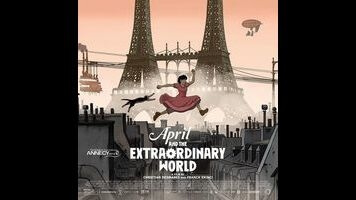What if, at the end of the 19th century, all of Earth’s most brilliant scientists and inventors started disappearing? In April And The Extraordinary World, what happens is that a mostly steam-powered, rapidly industrializing culture quickly exhausts the coal supply, such that by the 1930s the most powerful nations are fighting over North America’s lumber. By then, Europe has become a smoky, clanking dystopia, with cityscapes dominated by looming metal towers, connecting the massive cable-car lines that run across the continent. To get from Paris to Berlin through the skies takes 82 hours, once passengers depart from the docking station mounted between The City Of Light’s twin Eiffel Towers. And if the travelers are certified geniuses, they should beware. They could be zapped at any time by the mysterious black cloud that’s still rolling around the planet, picking off the smart people.
April And The Extraordinary World sprang from the mind of Jacques Tardi, the veteran French cartoonist who since the 1970s has been combining hardboiled genre fiction, freewheeling fantasy, and the “clear line” influence of Tintin creator Hergé. His best-known creation is the daring, drama-prone writer Adèle Blanc-Sec, whom writer-director Luc Besson brought to the screen in live-action form in 2010. But while Besson’s The Extraordinary Adventures Of Adele Blanc-Sec captured Tardi’s imaginative sense of design, it also emphasized outrageousness and slapstick in ways that undercut the source material’s matter-of-fact wonder.
The animated April is much closer to Tardi’s spirit, perhaps because he developed the story himself, with his old friend Benjamin Legrand and with animation directors Franck Ekinci (who worked on one of the TV versions of Tintin) and Christian Desmares (who was part of the crew that made Persepolis). There’s an appealing simplicity to this film, which doesn’t make a big deal out of its exotic version of the 1930s and ’40s—not even when the heroine visits a fun-fair where the Ferris wheel cars are miniature hot-air balloons, and gas-masked couples dance on a rotating carousel. The fantastical is framed as commonplace, because that’s how April herself experiences it.
Similarly, while Tardi and Legrand’s plotting is complex, it’s not overly complicated. April And The Extraordinary World moves logically and comprehensibly from one strange event to the next, until eventually everything that the audience needs to know is explained. That happens right around the time that an armored, walking house carries April to a man-made jungle biosphere occupied by giant bipedal reptiles. Because that’s the kind of movie this is.
Marion Cotillard provides the voice of April, who grows up an orphan, looked after by her talking cat Darwin (Philippe Katerine) after her scientist parents are struck down by the roaming black cloud. Squatting inside the head of a giant Napoleon statue, the teenage April spends her days trying to replicate the super-strength serum that her folks were developing when they were taken. But she has to keep her work secret from the French government, who via a gruff policeman have been sending a young spy named Julius (Marc-André Grondin) to keep tabs on her. Meanwhile, rats equipped with miniature cameras and listening devices have been secretly tracking April too, for the shadowy organization that may be behind her parents’ disappearance.
The original French title of April And The Extraordinary World could be translated as “twisted” or “rigged” instead of “extraordinary,” which would both be more apt. The movie’s Jules Verne-esque contraptions are fun to look at—and will make steampunk fans drool with delight—but by no means do Tardi and company want viewers to feel nostalgic for this alternate past. If anything, April uses the charcoal-roasted ’40s as an analogue for the oil-dependent 2010s, depicting an Earth on the brink of devastating war and ecological disaster because its resources have been mismanaged.
That’s not as depressing as it might sound, because the message is nestled within a story that’s so lively and well told. The filmmakers begin with a pair of lengthy prologues that leave a lot of threads dangling, but by about two-thirds of the way through they’ve picked them all up and have satisfactorily woven them back in, just in time for an extended climax filled with surprise twists and narrow escapes. This movie offers the kind of effortless Euro-adventure, full and fleet, that Steven Spielberg tried and mostly failed to deliver with his big-screen The Adventures Of Tintin.
April And The Extraordinary World also works just as a salute to human ingenuity, offering plenty of opportunities to marvel at the amazing machines that the world’s not-quite-geniuses have come up with. The film ends with renewed hope for the future, in a heartwarming epilogue which suggests that no matter the circumstances, humanity will keep backing itself into corners, but then will figure out a new way to move. If we can create the conditions that led to a Jacques Tardi, we can do anything.










![HBO teases new Euphoria, Larry David, and much more in 2026 sizzle reel [Updated]](https://img.pastemagazine.com/wp-content/avuploads/2025/12/12100344/MixCollage-12-Dec-2025-09-56-AM-9137.jpg)






























